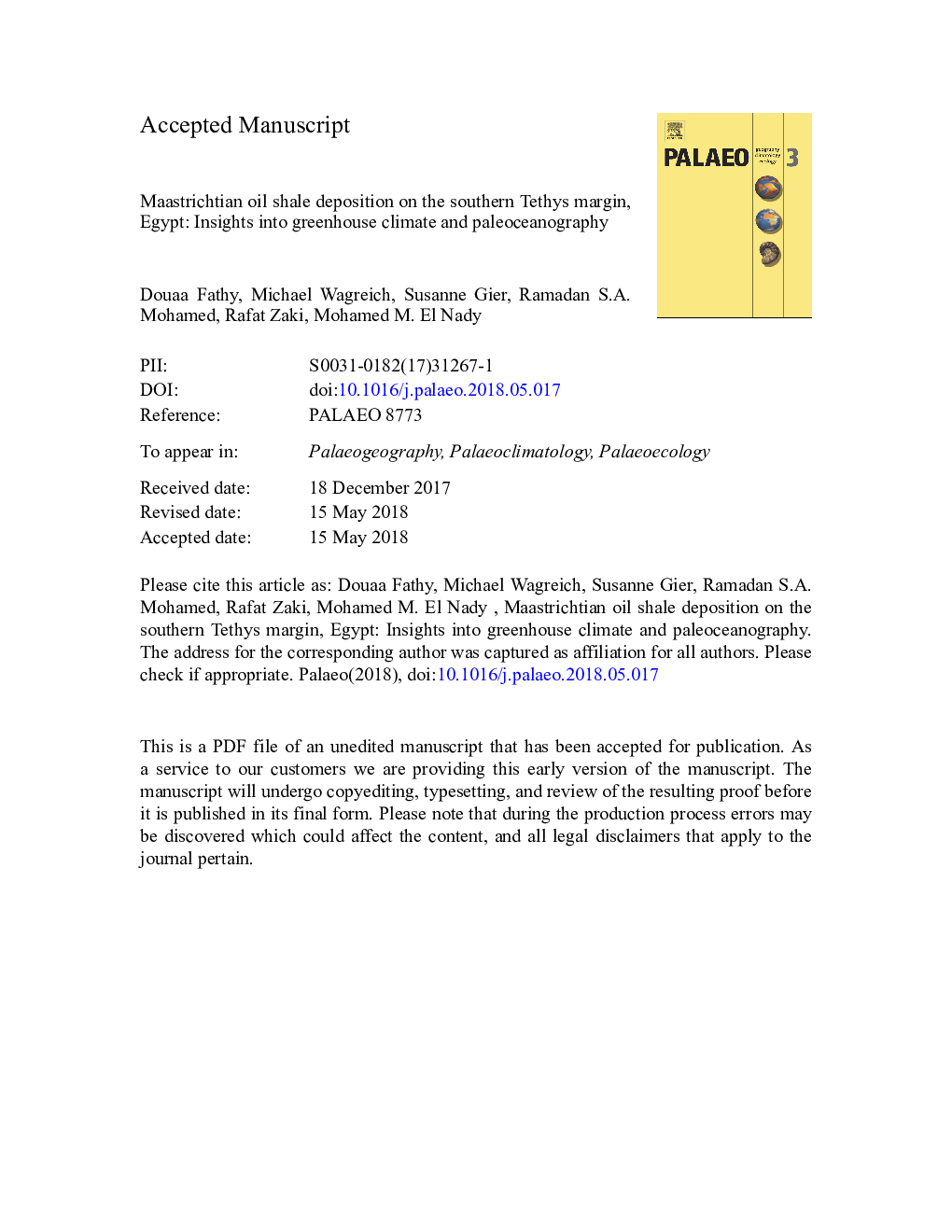| کد مقاله | کد نشریه | سال انتشار | مقاله انگلیسی | نسخه تمام متن |
|---|---|---|---|---|
| 8868118 | 1622087 | 2018 | 76 صفحه PDF | دانلود رایگان |
عنوان انگلیسی مقاله ISI
Maastrichtian oil shale deposition on the southern Tethys margin, Egypt: Insights into greenhouse climate and paleoceanography
ترجمه فارسی عنوان
رسوب گذاری شیلات ماستریختی در حاشیه جنوب تتیس، مصر: نگاهی به آب و هوای گلخانه ای و پالئوسکوئولوژی
دانلود مقاله + سفارش ترجمه
دانلود مقاله ISI انگلیسی
رایگان برای ایرانیان
کلمات کلیدی
کرتاسه بعدی شوری بهره وری سطح، سطح دریا، مواد ارگانیک،
موضوعات مرتبط
مهندسی و علوم پایه
علوم زمین و سیارات
فرآیندهای سطح زمین
چکیده انگلیسی
A comprehensive set of organic and inorganic geochemical proxies, clay mineralogy, and molecular fossils are presented from two biostratigraphically well-dated oil shale horizons of Egypt, within the Upper Cretaceous Duwi and Dakhla formations. The studied oil shales were deposited within intracratonic sedimentary basins in a broad northern African epeiric sea. Calcareous nannofossil biostratigraphy indicates that the oil shales range from early to late Maastrichtian in age, covering nannofossil zones UC18, UC19, and UC20. The oil shales contain smectite and kaolinite as the main clay minerals that formed by weathering of precursor basement rocks. The relative abundances of clay minerals and several geochemical proxies (e.g. C-value, CIA, Ga/Rb, Rb/Sr and Sr/Cu), along with the occurrence of warm-water nannofossil taxa, demonstrate that the Maastrichtian oil shales accumulated under a warm, arid to humid greenhouse climate during a general Maastrichtian cooling trend. This episode of oil shale deposition in Egypt coincided with the first potential imprint of the global warming, that has been recorded during early-to-late Maastrichtian times (~70.6-67.7â¯Ma). Elevated eolian terrigenous input was recorded within the Duwi Formation oil shales, shown by high Ti/Al, Si/Al, Zr/Al and low La/Lu ratios. The Duwi Formation environment was characterized by enhanced salinity and a stratified water column, compared to that of the Dakhla Formation, shown by elevated values of the gammacerane index, tetracyclic terpane, βâcarotene and Sr/Ba ratio. The CaCO3 content and carbonate/siliciclastic ratio indicate that the Dakhla Formation oil shales were deposited during a relative sea-level rise in a deeper marine setting than the Duwi Formation oil shales. The data further imply a wind-driven upwelling scenario of nutrient inputs that simulated primary production and increased organic matter fluxes. Thus, paleoclimate and paleoceanography had a considerable impact on organic matter enrichment.
ناشر
Database: Elsevier - ScienceDirect (ساینس دایرکت)
Journal: Palaeogeography, Palaeoclimatology, Palaeoecology - Volume 505, 15 September 2018, Pages 18-32
Journal: Palaeogeography, Palaeoclimatology, Palaeoecology - Volume 505, 15 September 2018, Pages 18-32
نویسندگان
Douaa Fathy, Michael Wagreich, Susanne Gier, Ramadan S.A. Mohamed, Rafat Zaki, Mohamed M. El Nady,
